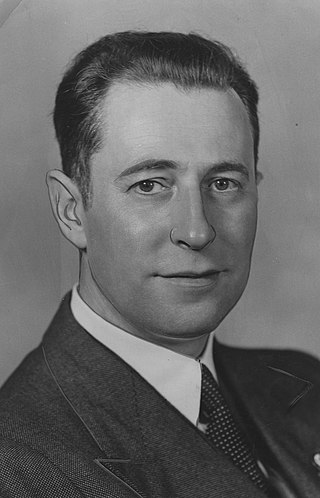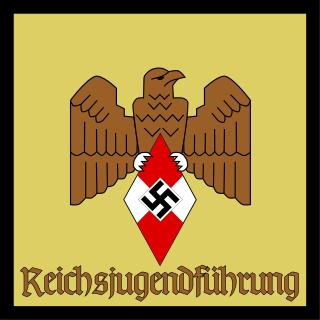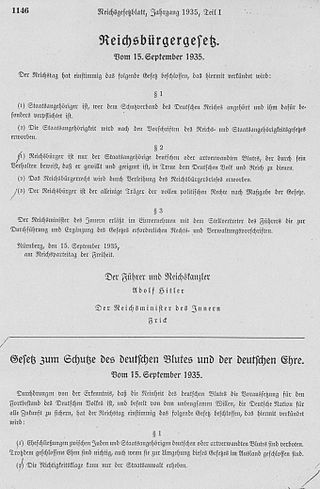Related Research Articles

August Franz Anton Hans Fritzsche was the Ministerialdirektor at the Propagandaministerium of Nazi Germany. He was the preeminent German broadcaster of his time, as part of efforts to present a more popular and entertaining side of the Nazi regime, and his voice was recognised by the majority of Germans.

The Hitler Youth was the youth organisation of the Nazi Party in Germany. Its origins date back to 1922 and it received the name Hitler-Jugend, Bund deutscher Arbeiterjugend in July 1926. From 1936 until 1945, it was the sole official boys' youth organisation in Germany and it was partially a paramilitary organisation. It was composed of the Hitler Youth proper for male youths aged 14 to 18, and the German Youngsters in the Hitler Youth for younger boys aged 10 to 14.

Jacob Otto Dietrich was a German SS officer during the Nazi era, who served as the Press Chief of the Nazi regime and was a confidant of Adolf Hitler.
Volksgemeinschaft is a German expression meaning "people's community", "folk community", "national community", or "racial community", depending on the translation of its component term Volk. This expression originally became popular during World War I as Germans rallied in support of the war, and many experienced "relief that at one fell swoop all social and political divisions could be solved in the great national equation". The idea of a Volksgemeinschaft was rooted in the notion of uniting people across class divides to achieve a national purpose, and the hope that national unity would "obliterate all conflicts - between employers and employees, town and countryside, producers and consumers, industry and craft".

Reichsjugendführer was the highest paramilitary rank of the Hitler Youth. On 30 October 1931, Hitler appointed Baldur von Schirach as the Reich Youth Leader of the Nazi Party. In 1933, after the Nazi seizure of state power, all youth organizations in Germany were brought under Schirach's control and he was designated the Jugendführer des Deutschen Reiches on 17 June. When Schirach was named Gauleiter of the Reichsgau Vienna on 8 August 1940, Artur Axmann succeeded him as Reichsjugendführer. Axmann had served as Schirach's deputy since 1 May 1940.

Georg August Friedrich Hermann Schulz, better known as Heinrich George, was a German stage and film actor.

Rassenschande or Blutschande was an anti-miscegenation concept in Nazi German racial policy, pertaining to sexual relations between Aryans and non-Aryans. It was put into practice by policies like the Aryan certificate requirement, and later by anti-miscegenation laws such as the Nuremberg Laws, adopted unanimously by the Reichstag on 15 September 1935. Initially, these laws referred predominantly to relations between ethnic Germans and non-Aryans, regardless of citizenship. In the early stages the culprits were targeted informally; later, they were punished systematically and legally.

The propaganda used by the German Nazi Party in the years leading up to and during Adolf Hitler's dictatorship of Germany from 1933 to 1945 was a crucial instrument for acquiring and maintaining power, and for the implementation of Nazi policies.

The Deutsches Jungvolk in der Hitlerjugend was the separate section for boys aged 10 to 13 of the Hitler Youth organisation in Nazi Germany. Through a programme of outdoor activities, parades and sports, it aimed to indoctrinate its young members in the tenets of Nazi ideology. Membership became fully compulsory for eligible boys in 1939. By the end of World War II, some had become child soldiers. After the end of the war in 1945, both the Deutsches Jungvolk and its parent organization, the Hitler Youth, ceased to exist.

This bibliography of Adolf Hitler is an English only non-fiction bibliography. There are thousands of books written about Hitler; therefore, this is not an all-inclusive list. The list has been segregated into groups to make the list more manageable.

Nazi eugenics refers to the social policies of eugenics in Nazi Germany, composed of various pseudoscientific ideas about genetics. The racial ideology of Nazism placed the biological improvement of the German people by selective breeding of "Nordic" or "Aryan" traits at its center. These policies were used to justify the involuntary sterilization and mass-murder of those deemed "undesirable".
Stephen H. Norwood is a professor of history at the University of Oklahoma. He received his PhD at Columbia University in 1984.

The propaganda of the Nazi regime that governed Germany from 1933 to 1945 promoted Nazi ideology by demonizing the enemies of the Nazi Party, notably Jews and communists, but also capitalists and intellectuals. It promoted the values asserted by the Nazis, including heroic death, Führerprinzip, Volksgemeinschaft, Blut und Boden and pride in the Germanic Herrenvolk. Propaganda was also used to maintain the cult of personality around Nazi leader Adolf Hitler, and to promote campaigns for eugenics and the annexation of German-speaking areas. After the outbreak of World War II, Nazi propaganda vilified Germany's enemies, notably the United Kingdom, the Soviet Union and the United States, and in 1943 exhorted the population to total war.

Kurt Eberhard was a German Nazi officer. He rose to the rank of Brigadeführer of the SS and in the German army. During World War II, Eberhard was given the command over the occupied city of Kyiv in Ukraine. He was involved in planning and supervising the Babi Yar massacres during which over 33,771 people were murdered.

This is a list of books about Nazi Germany, the state that existed in Germany during the period from 1933 to 1945, when its government was controlled by Adolf Hitler and his National Socialist German Workers' Party. It also includes some important works on the development of Nazi imperial ideology, totalitarianism, German society during the era, the formation of anti-Semitic racial policies, the post-war ramifications of Nazism, along with various conceptual interpretations of the Third Reich.

Nazi ideology could not accept an autonomous establishment whose legitimacy did not spring from the government. It desired the subordination of the church to the state. To many Nazis, Catholics were suspected of insufficient patriotism, or even of disloyalty to the Fatherland, and of serving the interests of "sinister alien forces". Nazi radicals also disdained the Semitic origins of Jesus and the Christian religion. Although the broader membership of the Nazi Party after 1933 came to include many Catholics, aggressive anti-church radicals like Alfred Rosenberg, Martin Bormann and Heinrich Himmler saw the kirchenkampf campaign against the churches as a priority concern, and anti-church and anti-clerical sentiments were strong among grassroots party activists.

The Roman Catholic Church suffered persecution in Nazi Germany. The Nazis claimed jurisdiction over all collective and social activity. Clergy were watched closely, and frequently denounced, arrested and sent to Nazi concentration camps. Welfare institutions were interfered with or transferred to state control. Catholic schools, press, trade unions, political parties and youth leagues were eradicated. Anti-Catholic propaganda and "morality" trials were staged. Monasteries and convents were targeted for expropriation. Prominent Catholic lay leaders were murdered, and thousands of Catholic activists were arrested.
Ben H. Shepherd is a British historian and author who specialises in German military history of World War II. He has authored several books on the German Army of 1935–1945. Shepherd holds the position of reader in history at the Glasgow Caledonian University.

On 30 January 1939, Nazi German dictator Adolf Hitler gave a speech in the Reichstag, which is best known for the prediction he made that "the annihilation of the Jewish race in Europe" would ensue if another world war were to occur.
References
- ↑ "Peter Fritzsche | History at Illinois". history.illinois.edu. Retrieved 24 May 2023.